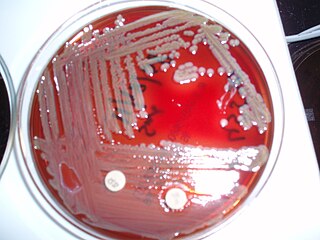In taxonomy, the Desulfurococcales are an order of the Thermoprotei.

In taxonomy, the Methanosarcinales are an order of the Methanomicrobia.
In taxonomy, the Methanosaetaceae are a family of microbes within the order Methanosarcinales. All species within this family use acetate as their sole source of energy.

The family Flavobacteriaceae is composed of environmental bacteria. Most species are aerobic, while some are microaerobic to anaerobic; for example Ornithobacterium, Capnocytophaga, and Coenonia.
Bergey’s Manual of Systematic Bacteriology is the main resource for determining the identity of prokaryotic organisms, emphasizing bacterial species, using every characterizing aspect.
Psychroflexus is a psychrophilic bacteria genus from the family of Flavobacteriaceae.
Psychroserpens is a Gram-negative and strictly aerobic bacteria genus from the family of Flavobacteriaceae.
Phenylobacterium is a Gram negative, strictly aerobic non-motile and bacterial genus from the family of Caulobacteraceae which can grow on chloridazon–mineral salts.
Hymenobacter is a Gram-negative and non-motile bacterial genus from the family of Flavobacteriaceae.
Aequorivita antarctica is a bacterium from the genus of Aequorivita which occurs in coastal antarctic sea-ice and antarctic seawater.
Aequorivita lipolytica is a bacterium from the genus of Aequorivita which occurs in sea water in the Antarctica.
Aequorivita sublithincola is a bacterium from the genus of Aequorivita which has been isolated from a quartz stone from the Antarctica.
Aquimarina is a strictly aerobic and halophilic bacterial genus from the family of Flavobacteriaceae. Aquimarina can cause diseases in marine eukaryotes.
Cryomorphaceae is a family of bacteria in the order Flavobacteriales which occur in marine habitats.
Cellulophaga is a Gram-negative, strictly aerobic and rod-shaped bacterial genus from the family of Flavobacteriaceae which occur in marine alga and beach mud. Cellulophaga species produce zeaxanthin.
Brumimicrobium is a Gram-negative and chemoheterotrophic bacterial genus from the family of Crocinitomicaceae.
Bergeyella is a rod-shaped, Gram-negative, aerobic, non-spore-forming and non-motile genus from the family of Flavobacteriaceae.
Bizionia is a strictly aerobic genus from the family of Flavobacteriaceae which produce carotenoids. Bizionia is named after Bartolomeo Bizio.
Zobellia is a strictly aerobic genus from the family of Flavobacteriaceae. Zobellia bacteria occur in marine habitats.
Polaribacter is a Gram-negative, heterotrophic, psychrophilic or mesophilic and aerobic bacteria genus from the family of Flavobacteriaceae.

